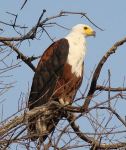This past January we took a three-week trip to southern Africa to golf and go on safaris. I of course also planned to do some semi-serious birding. Semi-serious in that I made no changes to our itinerary to see specific birds, but I did take with me a field guide of the most common 500 birds of southern Africa and my lightweight Leopold binoculars. I learned several things on this trip.
- There are many families of birds in southern Africa (in our case Zambia, Botswana, and South Africa) that are similar to birds here in Munds Park and were easy for me to identify. For example, we have the Pied Grebe species here, seen regularly in Lake Odell or the Pinewood Country Club’s ponds. The Little Grebe species of southern Africa is similar but even smaller. We were golfing, and there it was in a pond near the 1st tee box. It is so small that at first I thought it was a baby or juvenile. Another example is the African Fish-Eagle. It has a white head and dark body and you would think “Bald Eagle” when you first spot it. We see an occasional Bald Eagle in Munds Park soaring in the sky or perched high in a tree limb. We also get Canada Geese in Munds Park, and in Africa they get the Egyptian Goose. Both species are often considered pests at parks and golf courses because they are so common and so messy. One of the smaller, similar birds I identified was a Barn Swallow – almost exactly like the ones we have in Munds Park. And we have our Band-Tailed Pigeon, which is unique to the western United States. In Botswana I saw the Speckled Pigeon and the African Green Pigeon species.
- Another thing I learned is that there are many families of birds in Munds Park that have no connection to any in southern Africa, at least in my non-scientific opinion. I didn’t see nuthatches (we have White-Breasted, Pygmy, and Red-Breasted), or hummingbirds (we have Anna’s and Rufous) or anything similar to our Munds Park’s Black-Headed Grosbeak or Western Bluebird.
- There were a lot of bird families I had to become familiar with, and I was helped greatly because we had very knowledgeable safari guides with us. Bee-eaters, Barbets, Bulbuls, Hornbills, and Weavers were just some of the new bird families I saw, and within those families there were different unique species. The feather colors and sizes and shapes of their bills or head feathers always made for challenging and fun bird watching by all of us on the trip.
- Speaking of all of us on the trip, there were 12 of us, and everyone became a mini-birder during those three weeks. Everyone commented that seeing all the birds in between Lion or Hippo watching, for example, made the trip much more interesting. All in all I was able to identify 125 new bird species – without trying very hard.
- The last thing I learned is to be prepared. I took one pair of binoculars – I should have taken at least a second pair. I could have used stronger binoculars (such as a 10×50) for longer distances, plus others on the trip could have used my spare when I wasn’t. Having the field guide in advance was a real advantage. To translate that to Munds Park, I would suggest you have a field guide of US Western Birds, at minimum, handy in your house and invest in a decent pair of binoculars. I have used Eagle Optics and Amazon when ordering online, and you can find a satisfactory pair for under $200.
